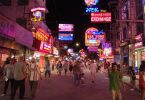The Prado Museum is one of the most prestigious art museums in the world. Alongside Velazquez’s Las Meninas and Goya’s The 3rd of May 1808 in Madrid: The Executions on Principe Pio Hill, the galleries are packed with masterpieces from the Spanish, Italian, and Flemish schools.
Storing over 8,000 artworks, the Prado Museum offers an expansive survey of Western paintings, from the Middle Ages to the 19th century. It is recommended that visitors read a guidebook to prepare for their visit and spend at least a full morning or afternoon at the museum, but don’t try to see the whole permanent collection in one day.
Spanish School
The Prado Museum houses the most comprehensive collection of Spanish paintings in the world. An itinerary can begin in the 11th century, contemplating the Mozarabic murals from the Church of San Baudelio de Berlanga, then move on to the canvases painted by Bartolome Bermejo, Pedro Berruguete, Juan de Juanes, or Luis de Morales to trace a timeline from Spanish-Flemish Gothic painting to the Renaissance. The galleries devoted to El Greco display some of the most unique examples of Mannerism, such as The Knight with his Hand on his Breast or The Holy Trinity.
The Golden Century is vastly represented through works by Ribera, Zurbaran, and Murillo, which explain the context that triggered Velazquez’s paintings, whose art peaked with Las Meninas and The Seamstresses, also on show in this museum. Halfway between the 18th and 19th centuries, the Goya galleries display artworks ranging from the tapestry cardboards he created for the Royal Tapestry Factory, to the Black Paintings he painted on the walls of his house, La Quinta del Sordo (Deaf-Man’s Villa). They make it easier to understand Spanish Romanticism. The last galleries in the itinerary are devoted to Sorolla, who in the early 20th century assimilated the cornerstones of the Spanish school – realism and color – and introduced concerns typical of modern painting.
Other Collections
The Garden of Earthly Delights, by Hieronymus Bosch
The shift from Medieval art to the Renaissance could not be explained without Italian painting, which also had a very strong influence on Spanish Baroque art. The most notable works from the Quattrocento (14th century) are Fra Angelico’s Annunciation, the chest with the story of Nastagio degli Onesti by Botticelli, Mantegna’s The Death of the Virgin, and Antonello da Messina’s The Dead Christ Supported by an Angel. Several of Raphael’s virgins justify the classicist splendor of the Cinquecento (15th century) and the canvases by Titian, Tintoretto, and Veronese -the stars of the Venetian school – and are some of the Prado Museum’s most acclaimed treasures. The different paths traveled by Italian Baroque art are clearly visible in artworks by Caravaggio, Guido Reni, and Annibale Carracci. Tiepolo’s production, from the 18th century, closes a cycle that started in the Renaissance and links Italian painting to the conflict between drama and beauty.
The Flemish school is very well represented given the political ties between the Spanish monarchy and Flanders. The Prado Museum accommodates works that range from relevant artworks by the primitive Flemish masters, like Van der Weyden’s The Descent from the Cross and Bosch’s The Garden of Earthly Delights, which Phillip II collected obsessively, to typical artworks produced during the Baroque splendor of the Brussels Court, with Rubens, the Brueghel Family, Jordaens, and Teniers topping the list of the most abundant authors in the Prado. French, Dutch, and German painting is also present in the museum’s collection. Durer, Claude Lorrain, Rembrandt, or Watteau are some of the other unmissable artists. Albeit less famous, the galleries devoted to sculpture and decorative arts are very interesting. Most notably, the Roman statues, the Dauphin’s Treasure – a dinner set inherited by Philip V – and artworks by the Leonis commissioned by Philip II and Charles V.
The Museum’s History
The Prado Museum opened for the first time on November 10, 1819. Thanks to the determination of Maria Isabel of Braganza, married to King Fernando VII, the building that Juan de Villanueva had initially designed to house the Natural History Cabinet finally accommodated an important part of the royal collections. Years of private donations and acquisitions enlarged the museum’s collection.
During the Spanish Civil War, the artworks were protected against potential bombings with sacks of sand and stored in the basement of the museum. In the end, as recommended by the League of Nations, the collection was taken first to Valencia and then to Geneva, although the paintings were quickly returned to Madrid when the Second World War broke out.
Prado Museum Temporary Exhibitions
The former Villanueva building accommodates a good part of the painting, sculpture, and decorative arts collections. Right behind it, around the Cloister of Los Jeronimos, architect Rafael Moneo constructed a series of galleries that accommodate temporary exhibitions, restoration workshops, an auditorium, a cafe, a restaurant, and offices. El Cason del Buen Retiro, once the dance hall of the now-disappeared Palace of El Buen Retiro, is also part of the museum. The edifice currently accommodates a library and a reading room for researchers.
In short, the Prado Museum is a must for art lovers.






















